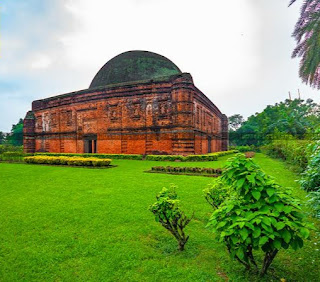Eklakhi Mausoleum (lit. ‘Mausoleum of One Lakh’) is yet another precedent of forced Islamic acquisition of Hindu religious monuments. Eklakhi Mausoleum is also located at Pandua, in Malda (WB) where lies the Adina Masjid. It was built in 1425-26. There are 3 three tombs inside the Mausoleum, belonging to Jalaluddin Muhammad Shah, his wife, and son Shamsuddin Ahmad Shah, but the identification is disputed.
According to historian Perween Hasan ‘the architecture may have been inspired by the brick temples in pre-Islamic Bengal. As Jalaluddin was the first native Muslim king of Bengal, he may have built the mausoleum in typical Bengali style, highlighting his roots.’ The mausoleum’s structure represents a thatched hut with a sloping roof forming eaves. It is the earliest example of the distinctive Bengali architecture which was popularised during the period of the Bengal Sultanate and later.
However there are other explanations.
According to some, Raja Ganesha (who had seized power in Bengal by overthrowing the Ilyas Shah dynasty in 1415) had built this as a mandir (temple). It was dedicated to goddess Chandi of whom he was a devotee. This mandir had 1 lakh (one lakh = ek lakh hence ‘ek lakhi’) ornate decorations on the walls and the construction of the temple cost him one lakh silver coins or ‘tankas'(tonka). Hence the name was Eklakhi Mandir. But Raja Ganesha’s elder son Jadu had converted to Islam (by his own will or by his father’s, that is another matter of debate, as there are various accounts by multiple historians) and had become king. After which he had converted this Mandir in to a Masjid.
Now according to historical accounts, Raja Ganesha and his son Jadu (converted to Jalal-Ud-Din) ruled in two phases. Initially Raja Ganesha overthrew the Ilyas Shahi dynasty and became the king in 1415. Then for some reason his elder son Jadu became Jalal-Ud-Din and ascended to the throne in 1416. Then after the death of the Sufi man who had converted him, Jalaluddin was reconverted to Hinduism by performing the Golden Cow ritual or the Hiranyagarbha ritual and Raja Ganesha yet again ascended the throne. After the death of his father Raja Ganesha, he once again converted to Islam and started ruling his second phase. It was probably during this phase that he converted the EkLakhi Mandir in to an Islamic monument.
